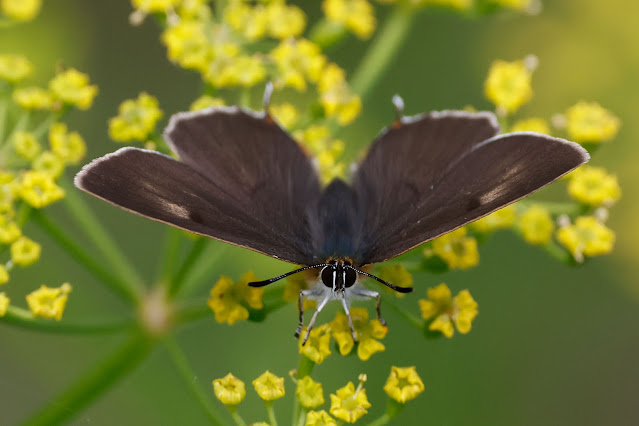Hard to believe it is August already, the year seems to be flying past. This morning I had arranged to meet Ian at the Shipton Belinger Village Hall car park. The site is just on the Hampshire - Wiltshire border and over the years has not been as successful as we would have hoped for. At least the weather today appeared to be playing ball, forecast as a sunny day, a rarity just lately as we have just endured one of the wettest July's on record.
We were here to find the Brown Hairstreak and hopefully some supporting cast and as we walked along the bridleway that leads to the main field we disturbed a few Red Admiral, not a surprise with the record numbers being seen this summer. We snuck through a gap in the hedge to walk onto the main meadow where at the back the tall trees provide the shelter and sun trap for the butterflies.
Both the short grass and the longer grass was full of the purple flowers of wild Basil and this was attracting the butterflies, Meadow Brown were everywhere, but there were also a few Common Blue. Here a male.
Gatekeeper were in the hedges.
A Green-veined White.
The sun was not quite out, although there was some hazy sunshine about. Not all the butterflies were ready to emerge, this male Brimstone still roosting under the leaves.
The trees at the back of the meadow are fronted by Hawthorn, Blackthorn and Bramble, down at ground level there is also a good amount of wild Fennel and plenty of Wild Basil and Self Heal, all in flower and attracting the insects.
Again no surprise, there was plenty of Red Admiral.
A Silver-washed Fritillary was a nice find, albeit a little worn it appeared from behind the taller trees.
As I watched the Holly Blue I noticed a darker butterfly with a distinctive fluttery flight, it settled on a nearby leaf, the one we had hoped to find and the first clear sighting of a Brown Hairstreak for quite a while.
Open winged this is a male, the Brown Hairstreak is our largest Hairstreak here in the United Kingdom. Both sexes have the dark chocolate brown upper wing with orange "tails", but the larger female has the orange band on the forewing, while the male just shows a smudge if at all.
Then it was gone, duelling once again with a Gatekeeper and this time I lost it completely. It was then back to searching, but there was always something about to keep you interested.
A Common Blue.
You find yourself walking up and down the line of trees staring at the leaves for a glimpse of orange. Gatekeepers set out to deceive you as they wind their way through the Fennel and the bramble.
One find was a Small Copper nectaring on the Self Heal.
Towards the east end of the bushes there was a group of Musk Thistles, a common plant of chalky soils and a source of nectar for many insects. Bumblebees were all over the flower heads and also a few Red Admirals and Peacocks. As I watched the butterflies I was joined by a Hummingbird Hawk-moth and it was moving between the flower heads.
As quickly as it would appear it would leave, flying up into the taller trees at the back. But it would return, or maybe others did as at one time there were three nectaring on the flowers.
I love Hummingbirds and have photographed many in the Americas, unfortunately the nearest you can get to those beautiful birds here in Europe is the Hummingbird Hawk-moth.
I changed the camera settings once it had flown away, increasing the shutter speed to try and capture the moth's wings, it was trial and error, this was set at 1/1000 and cleary was not fast enough as the moth fed on the Wild Basil
Then they were gone again and after waiting to see if they would return, it was back to the search for the Brown Hairstreak. Once again in doing so there were other butterflies to find too.
A Brown Argus
Back at the west end of the trees there were more Hummingbird Hawk-moths, this time nectaring amongst the Wild Basil and I was ready for them.
As with Hummingbirds you have to guess as to where it will go next as they move around the individual flowers very systematically.
The shout went up from others that there was a Brown Hairstreak at an acceptable level, so having filled my boots with the hawk-moth it was time for the real event.
A male once again, the underside orange colour is not as bright as the female, but still is a beatiful looking butterfly with the white "hairstreaks" and the orange tail.
The Brown Hairstreak is a local species that lives in self-contained colonies that breed in the same area year after year. This species can also prove elusive, since it spends much of its time resting and basking high up in tall shrubs and trees.
With so many shots we decided to try and find the other special butterfly here, the Wall Brown. Last year I did manage to find quite a few and I was a little surprised I hadn't seen any this morning. We walked around the area, sticking to the chalk exposed paths and places where maybe they would be basking, but to no luck.
We did though come through another large meadow.
And there was a surprise with this male Chalk Hill Blue.
Walking back to the main meadow there were a lot of Brimstone about now, mostly nectaring on the Wild Basil.
We did a few more circuits in search of Wall, but with out any luck. It was left to a Brown Hairstreak to put in an appearance on the stony ground instead.


_MG_5505.jpg)











































































No comments:
Post a Comment